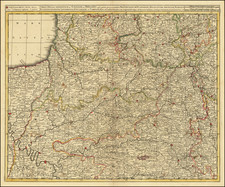First State of the First Italian-Issued Map of Thionville
Fine original antique battle map of Thionville by the great Lafreri artist Nicolas Beatrizet, showing the 1558 siege of the city. The view of the city shows French cannons pointing at the city, with encampments all around. This map was engraved in the Lafreri School style.
This finely engraved map shows the city of Thionville in the center, surrounded by the Moselle River. The many buildings within the city can be seen, and detail is particularly impressive.
The city of Thionville was a point of contention during the Italian War of 1551-59. This war was fought between the Habsburg Charles V and Valois Henri II, and was an attempt at a Habsburg reconquest of Italy and dominance in central European affairs. The war, in part, resulted in the division of the Habsburg empire. The war was particularly notable for the novel and extensive use of gunpowder. This can be seen on the map, with the many cannons both in and around the city, as well as the marching riflemen.
The Siege of Thionville resulted in a French victory led by Francis, Duke de Guise. However, the town did not remain under French control for long, as a treaty signed in 1559 returned all conquered territories back to their previous owners. However, all inhabitants were forced to leave the cities before they were exchanged, thus Thionville was returned empty.
A series of depictions of Thionville appeared in Italy in the mid-16th century, which Bifolco and Ronca argue stemmed from the presented map.
States
Four states are thought to exist for this map, per Bifolco and Ronca:
- Imprint: Nicolaus Beatrizet Lotaringus incidit: et formis.
- Imprint changed: Ionnes Orladi formis 1602
- Imprint changed again: Henric va Schoel formis 1602
- Hypothesized fourth state by Francesco de Paoli, thought to exist based on the plates appearance in the Paoli inventory.
This is the first state of the map.










![[Calais] Chales](https://storage.googleapis.com/raremaps/img/small/61301sb.jpg)
![[Chartres] Pourtraict ou plan de la Ville de Chartres](https://storage.googleapis.com/raremaps/img/small/75977.jpg)
![[Lorraine]. Carte Pour L'Intelligence De L'Histoire De Lorraine, ou on Fait Observaer La Genalogique De Ses Ducs, Et L'Ordre Du Governement Present](https://storage.googleapis.com/raremaps/img/small/73823.jpg)
![[Plan of the Siege of Guînes, France] Ritratto Della Fortezza di Ghines, presa perforza dallo essecito del Re Christianissimo . . .](https://storage.googleapis.com/raremaps/img/small/41817sb.jpg)
![[Plan of the Siege of Guînes, France] Ritratto Della Fortezza di Ghines, presa perforza dallo essecito del Re Christianissimo . . .](https://storage.googleapis.com/raremaps/img/small/75485.jpg)